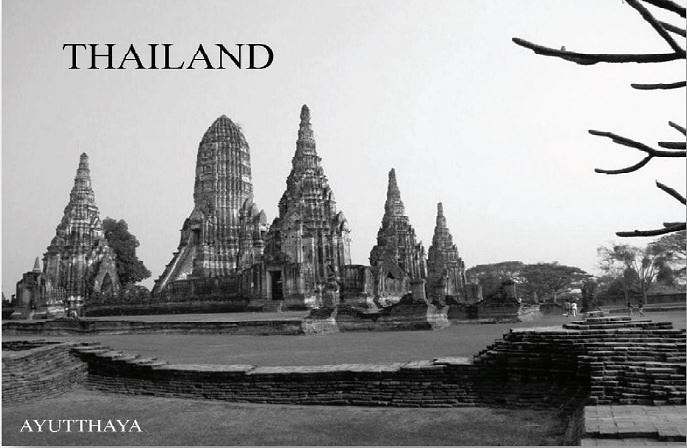
March 2010
Bangkok Airport is a hub for most international flights to Southeast Asia. Therefore, our itinerary included visits to the urban metropolis of Bangkok, both upon arrival for and before departure from a month-long trip to this fascinating part of the world, which for me included Myanmar, Laos, Vietnam, Cambodia, and Indonesia. This article is a compilation of both visits, beginning with my arrival from the United States.
At the end of a long journey, the Pantip Suites Hotel offered a respite with its lush gardens, soothing waterfalls, and charming statuary. This setting, along with an array of tropical fruit on the breakfast buffet, offered a glorious start to my first day in Bangkok. To become oriented in Thai history, I opted for a tour to Ayutthaya, a UNESCO World Heritage Site, which was the ancient capital for nearly 500 years and home to 33 kings from different dynasties between 1350 and 1767.
Ayutthaya is located on an island 47 miles from Bangkok. We traveled there by “Long Tail” boat, so named for its long, thin design. The hour-long ride on the Chao Phraya (King’s River) offered a glimpse into daily life by the water’s edge — the Royal Palace, the Queen’s house, ancient and new temples, a church, high-rise apartments, stilt houses, children swimming, people feeding plump carp, and a variety of boats. From a distance Ayutthaya resembled the ancient Khmer capital Angkor, ruled by god-kings with power mandated by divine forces. This was the model which had inspired the Ayutthaya monarchy.
Disembarking at Wat Chai Wattanaram, we walked about the temple complex and the ruins of the Royal Palace, set in a spacious green park. Built in the mid-15th century, the palace was burned down by the Burmese in 1763. Little remains of the original grandeur of the palace; all but some scattered foundations has been leveled. However, the three temple complexes we visited — Wat Chai Wattanaram, Wat Mongkol Bophit, and Wat Phra Sri Sanphet — contained visually arresting ruins displaying the dominance of Buddhism in the development of Thai culture.
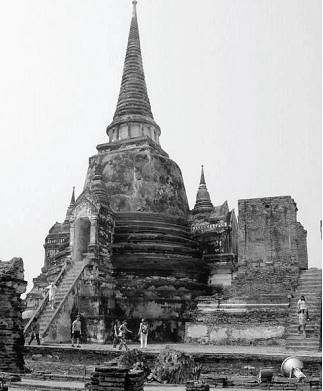
Chedi
A wat, which is much more than a place of worship, has numerous buildings for specific purposes. Brick chedis, which are bell-shaped stupas or pagodas with a conical top, dominate the grounds. Raised on square or round terraces of diminishing size, chedis, which were originally designed to hold sacred Buddha relics, were later built to cover and commemorate the remains of kings and saints. Prangs, also built for the same purpose, are soaring towers, slimmer in profile and more decorative than chedis. Their impressive stairways lead to ornate entrances.
Wat Mongkol Bophit houses the largest seated bronze Buddha statue in Thailand. Wat Phra Si Sanphet was the royal temple and palace for some Ayutthaya kings, who adopted the rituals of the Khmer royal court, carving a deep, impassible divide between royalty and subjects. The wat was both a private chapel and a ceremonial courtyard for royalty, who would arrive on gilded palanquins from the nearby Royal Palace. Its three symmetrically domed 15th-century chedis, which stand on a long central platform, were built to enshrine the ashes of important kings.
Our tour finished with a visit to an elephant camp. The elephant, Thailand’s national animal, is now endangered, with its population reduced from 500,000 to 5000. Since forests have been depleted, elephants are now mostly used for entertaining tourists by giving rides, doing tricks, or dancing. It was disheartening to see elephants trained to receive money from tourists by stretching out their trunks.
As we approached the outskirts of Bangkok on the way back, we cruised by slum houses alongside new constructions, which had attracted country people into the city for job opportunities, turning them into slum dwellers near where they worked. Thailand has a population of 64 million; the majority live near or around Bangkok, which is in the center of the country, surrounded by 76 provinces. Average annual income is $8000; there is a 7% sales tax on all goods. 37% of the population work for the government, which provides them with a pension and free health care. Education is free and compulsory until high school. The literacy rate is 92%.
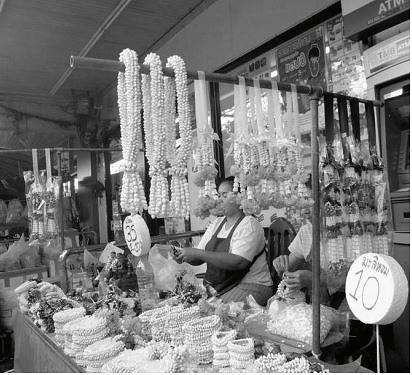
Flower stall with jasmine garlands
Wearing proper attire — long skirt or pants, shoulders covered, and no hats — for a visit to the Royal Palace, we started off our second day in the city. On the way we visited Chinatown. Of the 14% of Thailand’s population who are Chinese, 85% live in Bangkok’s Chinatown, famed for its temple with a Golden Buddha weighing 5.5 tons. Walking through the market, open from 6 am until 11 pm, gave us a glimpse of this bustling neighborhood. Outdoor flower stalls — with jasmine garlands and offerings for the Buddha, wedding bouquets, funeral wreaths, and a variety of orchids — provided intoxicating sights and smells. The tightly packed produce section offered a kaleidoscope of peppers, dragon fruit, lotus, lemongrass, packaged palm leaves, and other exotica. Similarly, a pocket of Hindu culture can be found in Little India.
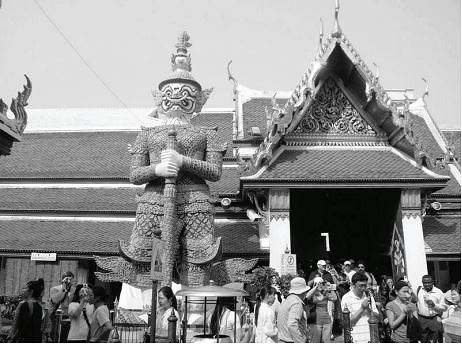
Wat Phra Kaeo
The Royal Palace and the adjoining Wat Phra Kaeo are the most dazzling sight in Bangkok, which became the new capital of the Kingdom of Siam, founded in the late 18th century after the fall of Ayutthaya. The temple and palace grounds are filled with other splendid buildings and sacred structures adorned with exquisite carvings, gold leaf murals, gilded towers, and ceramic mosaics; the sum creates a riot of color.
Most of these buildings are closed to the public, with the exception of the bot or chapel of the Emerald Buddha, a most holy statue and a symbol to the Thai people of the power, divinity, and enlightenment of their country. The image, actually carved from green jade, is only 26 inches tall, and is called “emerald” because of its color. Photography is prohibited, and visitors must remove their shoes before they enter. The palace, which has not been a royal residence since the absolute power of the monarchy was dissolved in 1925, fulfills a purely ceremonial function.
In Thailand, which means “Land of the Free,” there are 30,000 temples; 95% of the population are Buddhist. The king’s rule, though symbolic, is considered supreme; negative comments about the monarchy are punishable by law. The current king, Bhumibol (Rama IX) — born in 1927 in Cambridge, Massachusetts, where his father was studying medicine at Harvard — is the longest reigning king in Thai history. At 83, he is frail, but pictures of him at a young age are everywhere — in temples, streets, schools, shops, and homes. People do not want to see the aging king, whose daughter is in line to be queen. Since 1992, when elections were held to democratize Thailand, the king’s status has been ceremonial.
After an enjoyable lunch — served on a stationary boat on the Chao Phraya River and consisting of coconut dumplings, rice noodle soup, fried chicken with cashews, fish in cream sauce, and salad, followed by fruit — we visited two well known Bangkok shops, the Gems Gallery and Thai Square Fashion. The gallery displayed jewelry made of Thailand’s famed sapphires and rubies, in addition to other precious stones. Following a brief video about gems, each of us was escorted by a salesperson, who felt compelled to talk at the slightest pause in front of a display case. Not inclined to buy expensive jewelry, I felt overwhelmed by the experience.
The stop at Thai Square Fashion was an opportunity to order custom-tailored pants and shirts at a fraction of what they would have cost back home. We also had a demonstration of the difference between organic silk fiber and synthetic fabric. Exposed to a lit match, the former burned like hair, while polyester fabric gave out a rubbery smell. I opted to wait for something authentic rather than buy Western-style clothes from Thai silk. I was ready for a swim in the hotel pool, as the temperature in Bangkok begins hot and then becomes hotter and hotter, depending on the season and time of day.
The next morning we flew to Luang Prabang in Laos, returning to Bangkok three weeks later from Siem Reap in Cambodia. On our final evening in Bangkok, we enjoyed our farewell dinner on a converted wooden rice barge during a sunset cruise on the Chao Phraya River. The dinner menu included clear soup, chicken curry, stir-fried vegetables, Thai omelet, and sticky rice with mango wrapped in palm leaf.
We cruised past the Royal Palace and Wat Arun, the Temple of the Dawn, which looms 286 feet above the west riverbank. Built in Khmer style, the towering prang represents Mount Meru, mythological home of the Hindu gods. Its silhouetted form at sunset was a spectacle to behold.
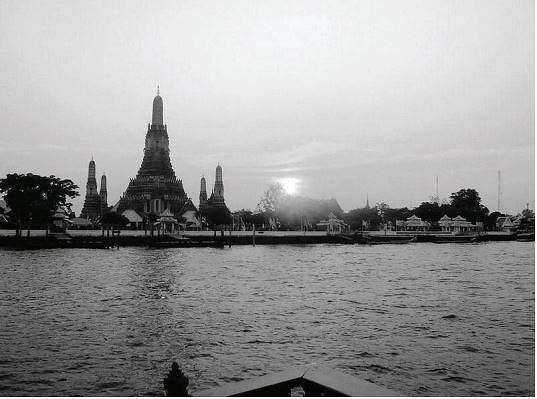
Wat Arun at sunset
My first visit to Bangkok had been in 2002. I remembered it as a steamy, crowded, noisy, sprawling city with maddening traffic; I could not wait to get to the mountainous north and the beaches in the south. While those areas of the country definitely merit a visit, my experience in Bangkok eight years later led me to appreciate the capital, despite its daunting aspects, as one of Asia’s great cities.
It is rapidly changing, with modern high-rises and shopping centers; yet the city’s historic sites, intriguing and culturally rewarding ethnic enclaves, ornate art and architecture, lively night life, riverfront attractions, and rich cuisine combine to provide full enjoyment. Thanks to the new spacious airport, going into and out of this great city is no longer the frenetic experience it used to be.
Here is my son Selim’s account of our trip to Thailand in February 2002:
“My mother and I have just returned from 2½ weeks in Thailand. It was such a wonderful experience that I had to share it.
Our transport and accommodations had been arranged by a tour operator, so it was nice not to worry about such matters. At the same time, we were free in each of the places we went either to participate in various excursions or to go around on our own, so we had a great deal of freedom and flexibility as well. It was a perfect combination.
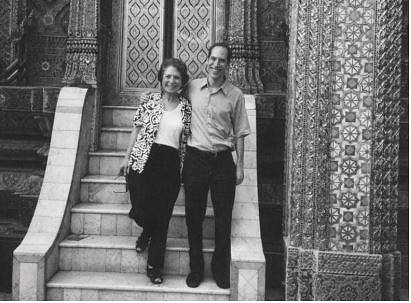
With Selim in Bangkok
We started off with three days in Bangkok, where we were overwhelmed by heat, size, traffic, noise, and general confusion. At the same time, we were impressed by the fact that the streets were clean and people (with the exception of tourists) neatly and colorfully dressed. The calm overhead walkways and modern sky-train stood in sharp contrast to the chaos of the streets and sidewalks below. And the amount of things to buy, from exquisite handicrafts to garish junk, was beyond imagination.
We then traveled to the North, where we visited three different cities. First was Chiang Mai, where we spent hours absorbed in the huge night market; visited silk, jade, teak, and lacquerware workshops; and had designs hand-painted on our clothes. This was where our wonderful local guide, Allen, got a busload of people to sing “Happy Birthday” for my mother and then proceeded to a solo rendition of “A Bicycle Built for Two” in her honor. We also spent a day walking around the city and discovering the labyrinthine covered market as well as numerous temples, the last one surrounded with wise sayings in Thai and English, including such classics as “Slow help is no help” and “Use not a reed to move a pole.”
Our next stop, after an all-day minivan drive including visits to tribal villages along the way, was in Mae Hong Son, where we were greeted by another absolutely charming local guide, Poongkee. We were also fortunate to have chosen the same itinerary as a very nice Flemish couple, Kathleen and Philippe, so we were in the best of company as the five of us traveled down the Mekong River, watching elephants majestically wading and climbing up the hillsides, to the Burmese border. There we visited a village of refugees from Burma, where the women lengthen their necks with heavy metal rings, traditionally as a sign of beauty and now, unfortunately, increasingly as a tourist attraction. Poongkee was full of interesting information and honest reflections here, just as she was a fountain of memories and inspiration in telling us about the life of “Our Buddha” in the temples we saw. We also enjoyed a lovely evening at a garden restaurant outside of town recommended by our friend John, where we got to know our guide and two travel companions better. And we were very happy that Philippe and Kathleen were able to help express our gratitude to Poongkee by meeting her in a cyber-cafe the next day and showing her how to set up an e‑mail account and use the Internet. A stay we will long remember with fondness.
Then we flew to the town of Chiang Rai, where we met our wonderfully friendly Chinese-born guide, Liu. I was ill for a couple of days, so I missed a long trip by elephant and boat to the Golden Triangle, which my mother greatly enjoyed, not least because of the close-up experience with the elephants. But I was better for a later visit to a cashew workshop and the annual flower festival, as well as a dinner complete with local music and dancing in the center of the night market, by now a familiar feature of Thai towns.
Finally, after two weeks of fascinating and educational but tiring adventure, we spent a few days on Phuket in the South. We were lucky to have chosen a good hotel with six restaurants, all included in the price of the room, plus a beautiful beach far away from the noisy towns. It was a welcome rest after all we had seen and done, and a perfect ending to a perfect holiday. It was difficult to imagine, as we sat on our last tropical evening under palm trees watching the sun set on the Indian Ocean, that the next day we would be back in the cold of Brussels or Boston and soon have to return to the drudgery of work in a life that seemed worlds away.
I had a somewhat stressful experience in leaving, as I discovered I had left my house and car keys in the first hotel where we had stayed in Bangkok. I arranged to have the keys delivered to Bangkok Airport, where I was to change planes on my way back to Frankfurt, but when I arrived at the airport the keys were nowhere to be found. After many frantic telephone calls, it turned out that they had been given to a driver coming to the airport, but that he had forgotten to leave them there. It turned into a race against time as I waited for the driver to make his way back to the airport through Bangkok traffic, with my flight leaving in less than an hour. Finally, at literally the last minute and after all hope of seeing my keys again had been lost, with my flight already boarding in another terminal and the ground staff hurrying me off, the driver rushed in, flushed and apologetic, with… yes, my keys!
Naturally I was quite relieved that I wouldn’t have to arrive in Brussels after a long overnight journey and worry about how to break into my apartment. Our perfect trip thus ended on a happy note after all.”
